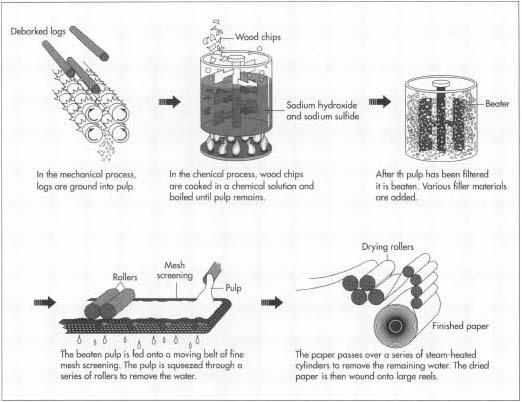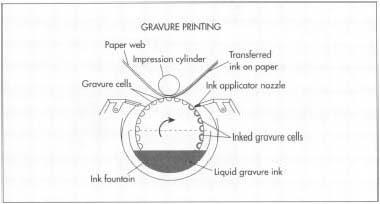Wrapping Paper
Background
There are many kinds of wrapping papers manufactured specifically for the types of products they are intended to wrap. For example, wrapping paper is made for bread for sanitary and aesthetic purposes. Originally, waxed paper and cellophane were used, but now polyethylene, polypropylene, and laminates that are a combination of these are preferred. Foil overwraps are also common.
History
Gift giving is associated with many holidays around the world and occasions such as birthdays. Like many other Christmas customs, exchanging gifts originated in ancient, pagan celebrations. The Roman festivals of Satumalia and Kalends were celebrations of the harvest and winter solstice included gifts of small figurines, food, jewelry, and candles. The Roman New Year featured gifts of candies, cakes, honey, and fruit because sweet gifts foretold a sweet year.
The tradition of giving gifts at Christmas time is associated with the gifts of gold, frankincense, and myrrh delivered to the Christ child by the Three Wise Men. Despite this link, gift-giving was shunned by the early Christians who associated it with the pagan traditions they wanted to leave behind. It was not until the Middle Ages that gift-giving became a popular custom associated with Christmas and the church's abhorrence of gift giving was essentially overwhelmed by popular practice. A whole phalanx of gift givers followed the Three Kings in entering popular culture. Saint Nicholas and Santa Claus (in many forms) are the best known of these; but Italy has the Befana, Russia has both the white-robed girl Kolyada and the ancient Babushka (grandmother), and Scandinavia calls on goats and dwarfs. In England, Boxing Day also arose as a gift-giving day; this day after Christmas was both a church holiday in which alms were given to the poor and a day when families gave boxed presents to their servants and to tradesmen.
The Victorians made an art form out of many holiday customs. Elaborate gift giving was a privilege of the rich, but the Victorians developed the Christmas card as a small gift that friends could give each other to express sentiments without spending a lot of money. The first Christmas card was designed by John Calcott Horsley in 1843 on commission from Sir Henry Cole, a businessman who had fallen behind in writing personal Christmas letters and wanted to send holiday greetings to those awaiting his letters. Before this printed card, people had decorated their calling cards with scraps of colored paper and this practice continued until about 1860 when the Christmas card began to grow into an industry. Developments in the printing industry and the creation of postage stamps helped to fire interest in mass mailing of cards.
The art of designing Victorian Christmas cards led to development of artistic gift wraps. Victorian Christmas papers were intricately printed and ornamented with lace and ribbon. Decorated boxes, loose bags, and coronets bore cutout illustrations of Father Christmas, robins, angels, holly boughs and other seasonal decorations. Often, the gift-wrapping papers matched cards in design, and the association of the two has carried through to today. Developments in printing presses allowed endless sheets of wrapping paper to be printed with consistent quality. The flexography process patented in England in 1890 combined very fluid inks with rubber plates wrapped around the print cylinder to make a printing process ideally suited to coarse or stiff papers that were durable enough for wrapping. The rotary system prints exceptional lengths of printed paper that are rolled on cardboard rolls or cut into smaller sheets.
In the United States, card-making companies expanded their product lines during the period from 1910 to 1925 by making printed or decorated gift wrap. Tissue paper had previously been available in green, white, and red; but sturdier paper was plain brown wrapping paper. Soon, gift wrap was accompanied by gift enclosure cards, and, in the 1980s, gift bags in a wide variety of sizes and shapes became the trend in disguising gifts, even though bags had originally been popular wrappers in Victorian times. Occasion appropriate papers and all the accessories to match are widely available for every gift-giving opportunity.
Raw Materials
Wrapping paper begins with paper that is produced in special mills from wood pulp. The pulp is usually made from trees classified as softwoods; for gift wrap, the pulp is bleached, but other papers like the material called kraft wrapping (familiar as grocery store bags) is made of unbleached pulp. Ink is made from natural and synthetic dyes. The emphasis on protecting the environment by using recyclable papers has been felt by both the paper-making and ink-making industries, which choose bleach and pigments that are easily recycled.
The strength of gift-wrap manufacturers may be in design over actual paper and ink production. The gift-wrap companies buy paper and ink from vendors that specialize in high-quality production of two weights of wrapping paper (called "giftcote" in the industry), heavier kraft paper, and tissue paper. The finished surfaces of certain wrapping papers, like foils, are impressed on the paper during the printing process.
Design
Design is the key to eye-catching gift wrap that will sell well. The design department of a major gift wrap manufacturer includes teams of designers divided into line designers, graphic designers, and artists. Line designers create the initial ideas for particular lines of gift wrap and all the related specialty items. The specialties include everything except greeting cards, although line designers often work with greeting card designers to producing matching or complementary products. Line designers include tissues, bows, ribbon, gift enclosures, wrapping papers, stickers or seals, and gift bags in their concepts.
Graphic designers also participate in design planning, but their primary task is to create artwork that will be used to make a template for the printer or paper mill to repeat over the surface of the gift wrap. Graphic designers may direct an idea to an artist in the gift-wrap finn's own design studio or an outside studio. If the wrap maker acquires the rights to use a familiar image like a cartoon character, the designer works with the artist or firm providing the image to develop a series of designs using that image in keeping with copyright laws. The artists may use any medium to create a gift-wrap design; many are hand-drawn or painted and lettered. The graphic and line designers work with the artist to select the colors, layout of the template, paper weight and style, and paper finish to best enhance the design. Completed designs are reviewed and approved then scanned onto computer records that can be distributed to the paper mill, printer, and others responsible for manufacture so that identical, error-free designs can be reproduced.
Meanwhile, the line designers direct completion of designs for other parts of the line. Gift tags are based heavily on gift wrap designs to so they will coordinate. The tags are complex items to design, however, because the tiny space restricts design possibilities and many special finishes or die-cut shapes are expensive to produce. Gift bags are also a large part of the gift wrap market with unique requirements. Again, designs may be based on gift paper plans or lines of cards, but individual lines of gift bags are also conceived. The bag itself is three-dimensional, so the designer must create designs for the

Line and graphics designers usually have private work spaces in the office, but they share larger planning rooms where designs, sample papers, references, and other materials for creating the current line can be spread out and shared. Design ideas must also be developed and discussed. Sources may include magazines, movies, traditional images, fashion and home fashion trends, as well as popular topics of conversation. Line designers may work on two to ten products within a single line at any time.
The Manufacturing Process
Manufacturing steps for gift wrap are relatively straightforward after the development and approval of a design is completed.
- Paper, ink, special finishes, and other items in the design line are purchased from paper and ink vendors. These materials are received and inventoried in the manufacturer's printing plant. A computer file with the digitized artwork from the design team is read by a machine that engraves the image onto a printing cylinder.
-
The printing cylinder is carefully inspected and fitted on a printing
press. The presses use rotogravure or flexography processes. Rotogravure
requires etched cylinders, while flexography uses rubber plates fitted
to a rotating cylinder. The
processes require inks unique to each process. Gift-wrap makers have state-of-the-art printing equipment that can apply up to six different colors simultaneously and add special finishes like foil, iridescent, pearlescent, and flocked finishes. As the paper emerges from the press, it is rolled onto large rolls and transferred to another part of the factory. Machines cut and wrap the paper in much smaller rolls for sale or format it for folding and sale in flat packages.
 Gravure printing is used to decorate wrapping paper.
Gravure printing is used to decorate wrapping paper. - Rolls of gift wrap are shrink-wrapped immediately with preprinted clear wrap bearing the manufacturer's information and price. Flat packages are also wrapped and sealed. Both types of gift wrap are bulk-packed in cartons for shipment to card shops, department stores, and other retail outlets.
Quality Control
Because the manufacture of gift wrap is so design-intensive, much of the product's quality is factored in before it ever reaches the manufacturing plant. All workers are responsible for product quality while the product is being processed in their area. In addition, quality control experts are part of the review and approval process during design and are on the floor of the plant throughout production.
Byproducts/Waste
Gift-wrap manufacturers generate lines of products for birthdays, weddings, Christmas, and many other holidays and occasions. Each line includes all the appropriate accessories customers may need for the particular occasion, and lines must be designed to appeal to a wide range of tastes.
Paper is the largest single waste item, and all waste paper is sold to recyclers who grind it up, remix it with appropriate types of pulp, and remanufacture paper from it. Ink waste results from leftover ink that is not fully used by printing of a particular line. The inks are chemically reformulated into new colors and reused. Some manufacturers such as American Greetings produce all of their own inks to make the most of this reformulation process as well as to produce unique qualities and colors of inks. Other makers who purchase ink from subcontractors recycle leftover inks through those manufacturers.
Where to Learn More
Books
Chalmers, Irena. The Great American Christmas Almanac. New York: Viking Studio Books, 1988.
Clements, Linda. The Spirit of Christmas Past: Evocative Memories of Years Gone By. New York: Smithmark Publishers, 1996.
Coffin, Tristram Potter. The Book of Christmas Folklore. New York: Seabury Press, 1973.
Del Re, Gerard, and Patricia Del Re. The Christmas Almanack. Garden City, NY: Doubleday & Company, Inc., 1979.
Rogers, Barbara Radcliffe. The Whole Christmas Catalogue. Los Angeles: Price Stem Sloan, 1988.
Sansom, William. A Book of Christmas. New York: McGraw-Hill Book Company, 1968.
Periodicals
"The Cover of Money." Time 136, no. 25 (December 10, 1990):73.
Other
American Greetings. http://www.americangreetings.com (July 18, 2000).
CPS Corporation. http://www.cpscorp.com (July 18,2000).
Gibson Greetings. http://www.gibsongreetings.com . (July 18, 2000).
Hallmark. http://www.hallmark.com (July 18,2000).
— Gillian S. Holmes
Comment about this article, ask questions, or add new information about this topic: